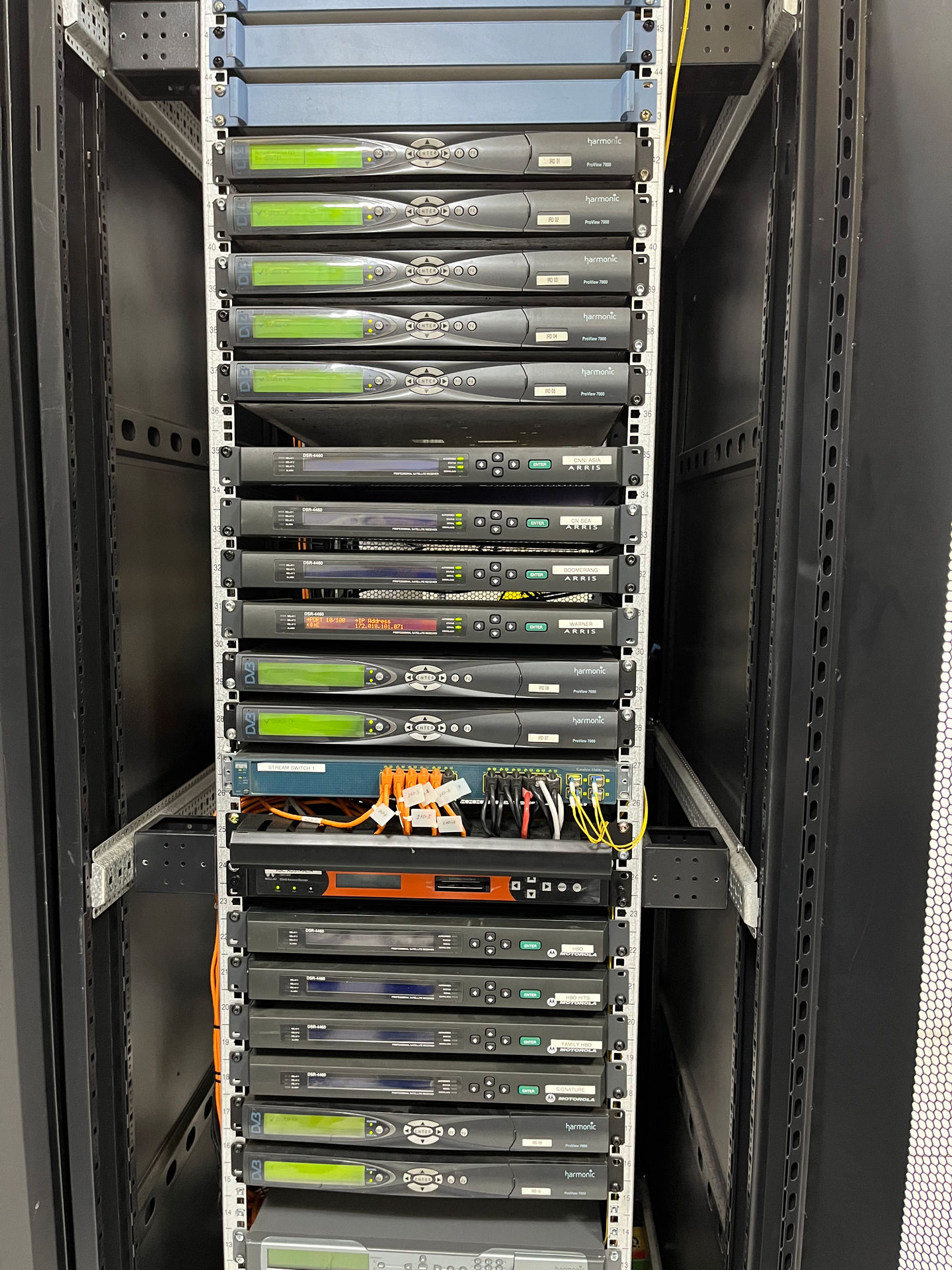Tour of Skytel IPTV Headend
Last month after the mnNOG 5 event in Mongolia, I got a chance to visit Skytel’s IPTV headend. Skytel is one of the large Mongolian operators doing mobile and fixed-line networks. Tour of network infrastructure is always interesting and this time it was not just IP but broadcast network over the IP which excited me. In past, I have visited datacenters, IXPs etc and those are mostly IP (layer 3) or ethernet (layer 2) networks. This was the first time a tour of the broadcast infrastructure. Special thanks to friends from Skytel especially my friend Tuvshuu from the IP broadcast network team for arranging this tour of this infrastructure.
Overview
All this involves satellites, yes IPTV and satellites!
Satellites, lots of them!
It’s kind of interesting that while ISP IP traffic has mostly moved away from satellites (i.e. there is negligible internet traffic over satellites percentage-wise except recent addition of Starlink), the broadcast traffic still heavily uses satellites. This is because it’s more reliable, cheaper and not latency-sensitive as opposed to internet traffic. Geostationary satellites operating in geostationary orbit are around 35,786km from Earth and this is a special distance as satellites in this orbit have the same rotational period as that of Earth and hence satellites seem “stationary” when seen from the earth.

Essentially broadcasters like Star, ABC, BBC, and Discovery produce/purchase/access various programs, they transcode them and send them to multiple satellites from where it is sent back to the Earth to various cable & satellite TV headends. This gives a point to multipoint distribution i.e. Earth station feeding an Asian satellite which feeds back to a large geography of Asia. Now the MSO (Multiple Systems Operator) collects these signals from different satellites, transcodes them and delivers them to the end user.
This delivery to end user can be on various technologies like:
- HFC - Hybrid Fibre Coaxial
- Satellite (DTH)
- IPTV over unicast network
- IPTV over multicast network
While #1 and #2 came earlier, increasingly they are being replaced over time because the internet anyway is needed in more and more homes, a cable carrying the internet is reaching the end user in large to mid-sized towns and if effort is being put to maintain the infra for internet, why not use the same for delivery of the broadcast TV signal as well.
IPTV
This brings us to IPTV. Ultimately the future of distrubuting TV broadcast. While demand for live TV is reducing, there is still a very high demand for live channels and for homes having internet in place (specially over fibre). IPTV provides an option to deliver the traffic using the same infra. IPTV is simply TV over the Internet Protocol and because there is no hard definition of it, in theory, one can call live TV streaming over YouTube also as IPTV. Though most of people consider a large number of free/paid channel access over the IP as IPTV. This is typically done by an MSO who can deliver it. For the IPTV over unicast network, technically one can deliver TV simply over any network including the internet but often that is not done because of regulations and even capacity reasons.
One challenge with IPTV over the unicast network is the capacity in aggregate terms. A standard definition channel takes around 3-4Mbps while an HD channel takes 5-8Mbps. Multicast solves this problem by carrying (essentially replicating the same signal) to anyone who needs it. Thus the impact of the end user on the backend is negligible. Multicast packets are essentially replicated on each device and hence the difference of 1 or more than one (millions) is none on the backend. It has its own set of problems like one has to carry a fibre/ethernet cable to each TV/Set top box and that can be a pain in the age of wifi. Plus no support for end devices like phones, tablets etc. It’s the same signal stream which has to be played by a known/designed set top of boxes.

Skytel receiving dishes

These dishes receive signals from various satellites. The number of channels depends on satellites. Often a broadcaster would send all their channels from a single satellite and there is often (way more than 1) broadcaster using that satellite. E.g for a satellite like Intelsat, has channels from Korean networks like KBS to Discovery, Indian news channels to Sony Sports, China radio to Cape Town TV etc. Current complete list here. These often use the C band (3.7 GHz to 8 GHz). This is the lower frequency in contrast to KU band 12-18Ghz which is used by the DTH industry. Low frequency = higher wavelength and hence large dishes typically in 1.8m to 2.4m. In contrast, the KU band dish size is just 60cm. These large C-band dishes require lots of space and are often located in regions outside of the main city to ensure a clear line of sight as well as to avoid interference. This C band signal is next carried using thick coaxial cables to a network rack in a closed area. Often the free channels are non-encrypted and are simply passed to an encoder. For the paid channels, it’s common to have a de-coder to de-crypt the signal first using the card provided by the broadcaster (and in some cases, the decoder itself is provided by the broadcaster).
Here’s what this setup looks like:

On top there are 5 x ProView 7000 1U devices. These can process MPEG1 / MPEG 2 / MPEG 4 format, decode the signal and make it available over the IP network. It can multiple multiple channels before giving the IP output on ASI (Asynchronous Serial Interface) or IP. All these feed to the ethernet switch in the centre where this traffic is aggregated over the optical fibre (4 x 10G ports on the right) and is carried to Skytel datacenter in Ulaanbaatar. From here these streams are sent over multicast network to end users who have subscribed to IPTV. This involves having a CAS (Conditional Access System) which maintains subscription management for the end users.
Concept of RFoG
While the large dishes here were connected over coax, increasingly over time these are being replaced with fibre. This is often referered to as RFoG i.e RF over glass. This allows carrying raw frequency (an analog signal) over a medium like fibre which carries only digital signal (pulses of light). This reduces the size of cables, and the overall weight of the system (which becomes important when doing installation and maintenance etc) and also allows for placement of encoders somewhere far away as signal loss on the fibre is way lower than the coaxial cables.
Indian Bollywood in Mongolia
I visited Skytel’s NOC in Ulaanbaatar city and like other NOCs they had a large number of screens mounted on the wall giving information about their network from various NMS sources. No pictures for that since it did have some confidential information, however some of the screens were running live TV and I noticed a familiar face:

That’s famous Indian actor Shahrukh Khan in a movie running over the Mongolian National Broadcaster (MNB) TV. I don’t watch Bollywood movies that often but a quick search with the image reveals this was Asoka movie from 2001.
And with this tour, I ended my trip to Mongolia. It was a good place to visit and one of the best country NOGs in the region. 😀